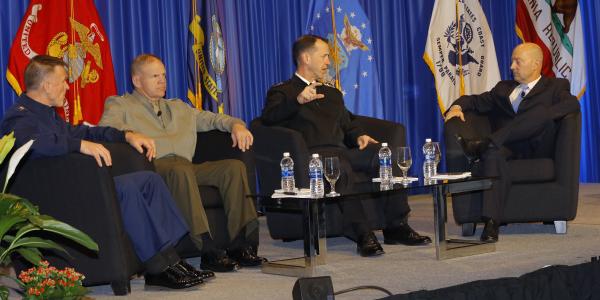More Funding Not a Cure-all for Sea Services
The U.S. Navy, Marine Corps and Coast Guard all are targeting badly needed upgrades using funds proposed in the latest defense budget. But money alone won’t solve problems that have been building for more than a decade. And, potential adversaries have changed the international security game with new forms of combat that will require shifts in focus away from traditional approaches.
The three service chiefs outlined their challenges and opportunities in the final keynote session of West 2018 in San Diego February 8. Marine Corps Commandant Gen. Robert B. Neller, USMC, said of Congress, “If they can do a multiyear budget without having to deal with the budget control act, that will help us because we can plan. The adversary out there is making big investments.
“Looking at the joint world, we have to have reliable command and control,” Gen. Neller continued. “From the naval perspective, we need more attack submarines. We will have to fight to get to the fight.”
Looking at the joint world, we have to have reliable command and control. We have to protect our networks.—Gen. Robert B. Neller, USMC, commandant, U.S. Marine Corps #WEST2018 @GenRobertNeller
— Bob Ackerman (@rkackerman) February 8, 2018
Chief of Naval Operations Adm. John M. Richardson, USN, offered specifics on Navy priorities. “Replacing Trident SSBNs is the number one acquisition program in the U.S. Navy,” he declared. He added that some of the rapid acquisition programs for directed energy weapons and unmanned undersea vehicles are changing Navy acquisition.
The future security industry is going to be defined more and more by maritime.—Adm. John M. Richardson, USN, chief of naval operations #WEST2018 @CNORichardson
— Bob Ackerman (@rkackerman) February 8, 2018
However, he warned not to expect a 355-ship Navy too quickly. The Navy must replace older ships as it adds to the force, and the shipbuilding industrial base is only one-third of what it was in 1955. The Navy is looking at alternatives to linear shipbuilding production. “We have a family of plans, some status quo. It takes a long time to get to 355 ships. Every trick in the book is on the table,” he stated.
Adm. Paul F. Zukunft, USCG, commandant of the U.S. Coast Guard, offered a global view of the downturn in shipyards. “If someone were to pose an existential threat to the United States, would it wake up that lion that the Japanese did in 1941? Do we have the surge capability?” The Coast Guard clearly needs to build new icebreakers, he added. And, he warned that the sealift fleet is so old that there are few mariners left who can operate these steamships.
We need to look at bandwidth that can withstand the actions of an adversary.—Adm. Paul F. Zukunft, USCG, commandant, U.S. Coast Guard #WEST2018 @ADMZunkunft
— Bob Ackerman (@rkackerman) February 8, 2018
Yet Adm. Zukunft offered that the services must strive to build strength using alternative methods instead of ruing shortcomings. “The more we bemoan our readiness, the more an enemy is incentivized,” he said.
As Russia continues to fund and advance in the maritime, particular their undersea capabilities, we have to keep up with them.—Adm. John M. Richardson, USN, chief of naval operations #WEST2018 @CNORichardson
— Bob Ackerman (@rkackerman) February 8, 2018
Both China and Russia are potential adversaries, and they aren’t holding back in their efforts to claim military superiority over the United States. “As Russia continues to fund and advance in the maritime, in particular their undersea capabilities, we have to keep up with them,” Adm. Richardson said. Gen. Neller pointed out, “The adversary we had in the 1980s went away, and then it came back in another form. We now have other adversaries, and they’ve got game. We have to compete.”
The adversary we had in the 1980s went away, and then it came back in another form. We now we have other adversaries, and they’ve got game. We have to compete.—Gen. Robert B. Neller, USMC, commandant, U.S. Marine Corps #WEST2018 @GenRobertNeller
— Bob Ackerman (@rkackerman) February 8, 2018
When queried, all three sea service chiefs stated they did not support the creation of a separate cyber force. In this, they disagreed with moderator Adm. James G. Stavridis, USN (Ret.), dean of The Fletcher School of Law and Diplomacy, Tufts University. Adm. Stavridis offered a prediction for all to consider: "In 50 or 100 years, we’ll look back and say, 'What were we thinking that we didn’t have a cyber service?'"
In 50 or 100 years, we’ll look back and say, what were we thinking that we didn’t have a cyber service?—Adm. James G. Stavridis, USN (Ret.), dean, The Fletcher School of Law and Diplomacy, Tufts University #WEST2018 @stavridisj
— Bob Ackerman (@rkackerman) February 8, 2018



Comments